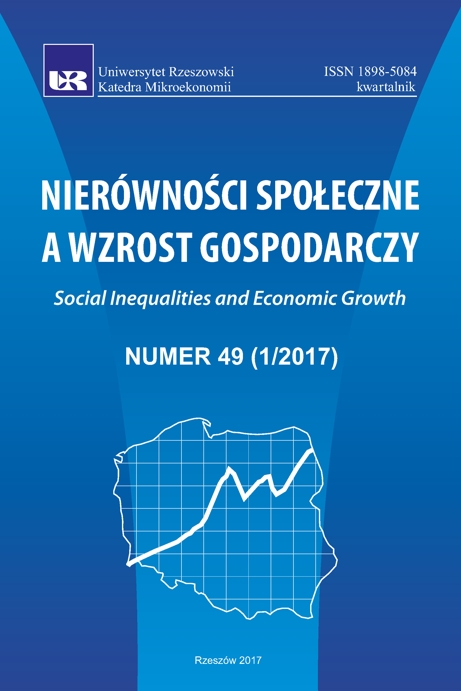Nierówności dochodowe samorządów gminnych
DOI:
https://doi.org/10.15584/nsawg.2017.1.30Słowa kluczowe:
nierówności dochodowe, indeks Theila, dochody gminAbstrakt
Kluczowym zagadnieniem w realizacji zadań przez samorządy gminne jest zapewnienie odpowiednich zasobów finansowych. Wysoki poziom dochodów własnych per capita, a także ich wysoki udział w dochodach ogółem świadczą o wysokim poziomie samodzielności finansowej gmin, sprzyjają lepszemu zaspokojeniu potrzeb mieszkańców i stanowią podstawę stabilnego rozwoju lokalnego. Potencjał dochodowy gmin wynika z uwarunkowań zewnętrznych takich jak koniunktura gospodarcza kraju, ale również z lokalizacji jednostki, posiadanych surowców naturalnych, warunków przyrodniczych, ponadto uwarunkowany jest wewnętrznymi czynnikami społeczno-gospodarczymi. Czynniki te sprawiają, że w potencjale dochodowym samorządów lokalnych występują dysproporcje związane z typem administracyjnym gmin czy lokalizacją w województwach. Celem przeprowadzonych badań była diagnoza poziomu nierówności dochodowych gmin w Polsce w latach 2005–2014. Rozpatrywano dochody ogółem oraz dochody własne samorządów gminnych. Gminy analizowano w przekroju ich typów administracyjnych oraz województw. Podstawę informacyjną badań stanowiły dane dotyczące poziomu dochodów własnych oraz dochodów ogółem per capita w gminach z wyjątkiem miast na prawach powiatu. Dane pochodziły z baz danych publikowanych Główny Urząd Statystyczny. Oceny nierówności dochodowych gmin w Polsce dokonano na podstawie wartości współczynnika Theila.Największe nierówności dochodowe o malejącej tendencji w zakresie dochodów własnych stwierdzono w obrębie gmin wiejskich, co może wynikać ze znacznego zróżnicowania ich typów funkcjonalnych. Rozpatrując gminy w poszczególnych województwach, najwyższy poziom nierówności w rozkładzie dochodów własnych odnotowano w województwie mazowieckim, a najniższy w województwie lubuskim. Nieznaczne nierówności w rozkładzie dochodów własnych stwierdzono pomiędzy typami administracyjnymi gmin oraz województwami. Na niewielkim, zbliżonym do zera poziomie odnotowano również nierówności w rozkładzie dochodów ogółem dla gmin w Polsce.Downloads
Download data is not yet available.
Pobrania
Opublikowane
2020-11-13
Jak cytować
Głowicka-Wołoszyn, R., Wołoszyn, A., & Kozera, A. (2020). Nierówności dochodowe samorządów gminnych. Nierówności Społeczne a Wzrost Gospodarczy, 1(49), 396–405. https://doi.org/10.15584/nsawg.2017.1.30
Numer
Dział
Artykuły
Licencja
Prawa autorskie (c) 2017 Uniwersytet Rzeszowski

Utwór dostępny jest na licencji Creative Commons Uznanie autorstwa – Na tych samych warunkach 4.0 Miedzynarodowe.


